disc FIAT DUCATO 244 2005 3.G Owners Manual
[x] Cancel search | Manufacturer: FIAT, Model Year: 2005, Model line: DUCATO 244, Model: FIAT DUCATO 244 2005 3.GPages: 258, PDF Size: 4.05 MB
Page 2 of 258
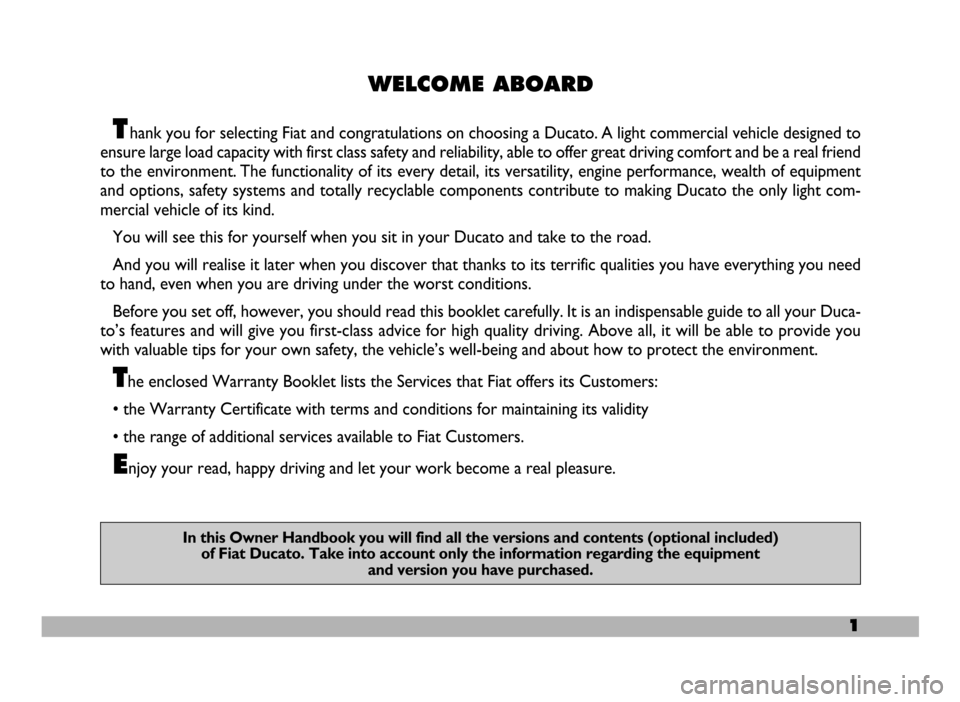
1
WELCOME ABOARD
Thank you for selecting Fiat and congratulations on choosing a Ducato. A light commercial vehicle designed to
ensure large load capacity with first class safety and reliability, able to offer great driving comfort and be a real friend
to the environment. The functionality of its every detail, its versatility, engine performance, wealth of equipment
and options, safety systems and totally recyclable components contribute to making Ducato the only light com-
mercial vehicle of its kind.
You will see this for yourself when you sit in your Ducato and take to the road.
And you will realise it later when you discover that thanks to its terrific qualities you have everything you need
to hand, even when you are driving under the worst conditions.
Before you set off, however, you should read this booklet carefully. It is an indispensable guide to all your Duca-
to’s features and will give you first-class advice for high quality driving. Above all, it will be able to provide you
with valuable tips for your own safety, the vehicle’s well-being and about how to protect the environment.
The enclosed Warranty Booklet lists the Services that Fiat offers its Customers:
• the Warranty Certificate with terms and conditions for maintaining its validity
• the range of additional services available to Fiat Customers.
Enjoy your read, happy driving and let your work become a real pleasure.
In this Owner Handbook you will find all the versions and contents (optional included)
of Fiat Ducato. Take into account only the information regarding the equipment
and version you have purchased.
Page 14 of 258
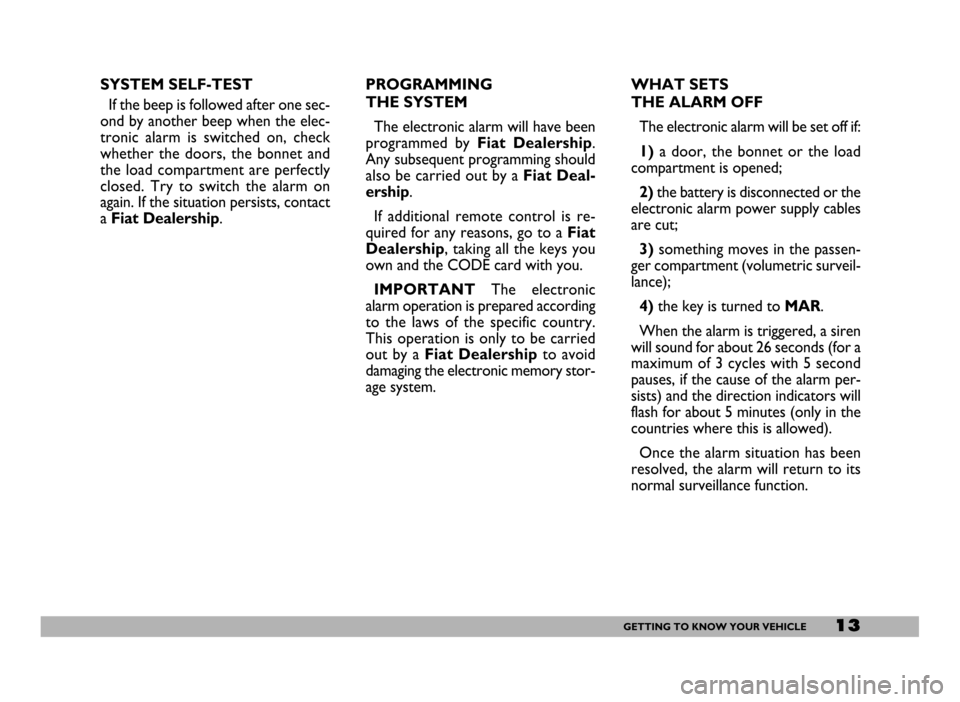
13GETTING TO KNOW YOUR VEHICLE
SYSTEM SELF-TEST
If the beep is followed after one sec-
ond by another beep when the elec-
tronic alarm is switched on, check
whether the doors, the bonnet and
the load compartment are perfectly
closed. Try to switch the alarm on
again. If the situation persists, contact
a Fiat Dealership.WHAT SETS
THE ALARM OFF
The electronic alarm will be set off if:
1) a door, the bonnet or the load
compartment is opened;
2) the battery is disconnected or the
electronic alarm power supply cables
are cut;
3) something moves in the passen-
ger compartment (volumetric surveil-
lance);
4) the key is turned to MAR.
When the alarm is triggered, a siren
will sound for about 26 seconds (for a
maximum of 3 cycles with 5 second
pauses, if the cause of the alarm per-
sists) and the direction indicators will
flash for about 5 minutes (only in the
countries where this is allowed).
Once the alarm situation has been
resolved, the alarm will return to its
normal surveillance function. PROGRAMMING
THE SYSTEM
The electronic alarm will have been
programmed by Fiat Dealership.
Any subsequent programming should
also be carried out by a Fiat Deal-
ership.
If additional remote control is re-
quired for any reasons, go to a Fiat
Dealership, taking all the keys you
own and the CODE card with you.
IMPORTANTThe electronic
alarm operation is prepared according
to the laws of the specific country.
This operation is only to be carried
out by a Fiat Dealershipto avoid
damaging the electronic memory stor-
age system.
Page 69 of 258
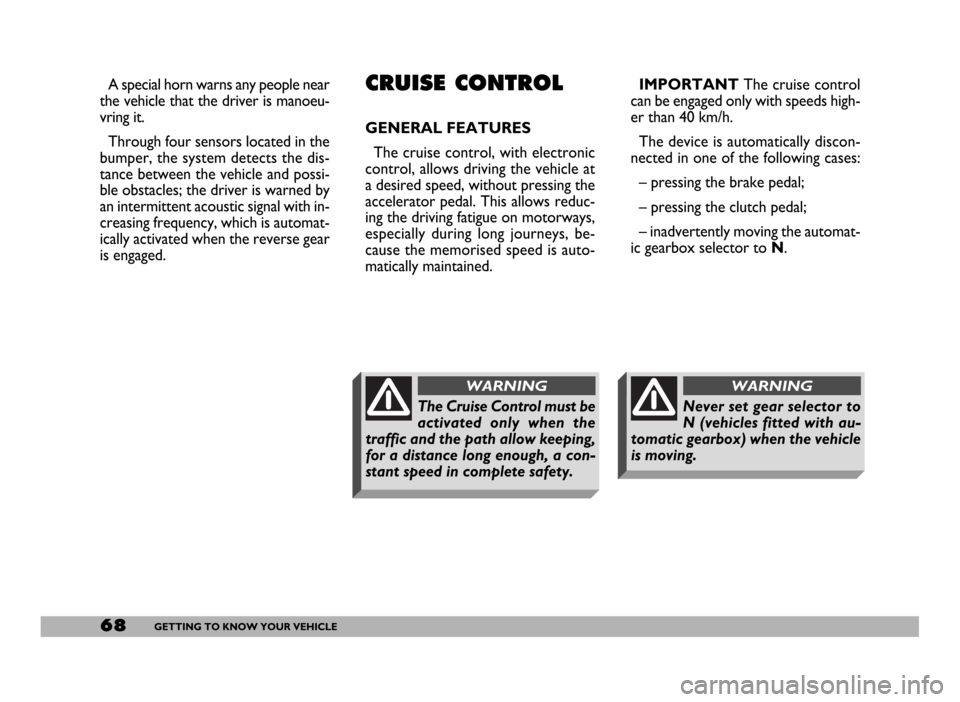
68GETTING TO KNOW YOUR VEHICLE
IMPORTANTThe cruise control
can be engaged only with speeds high-
er than 40 km/h.
The device is automatically discon-
nected in one of the following cases:
– pressing the brake pedal;
– pressing the clutch pedal;
– inadvertently moving the automat-
ic gearbox selector to N. A special horn warns any people near
the vehicle that the driver is manoeu-
vring it.
Through four sensors located in the
bumper, the system detects the dis-
tance between the vehicle and possi-
ble obstacles; the driver is warned by
an intermittent acoustic signal with in-
creasing frequency, which is automat-
ically activated when the reverse gear
is engaged.CRUISE CONTROL
GENERAL FEATURES
The cruise control, with electronic
control, allows driving the vehicle at
a desired speed, without pressing the
accelerator pedal. This allows reduc-
ing the driving fatigue on motorways,
especially during long journeys, be-
cause the memorised speed is auto-
matically maintained.
Never set gear selector to
N (vehicles fitted with au-
tomatic gearbox) when the vehicle
is moving.
WARNING
The Cruise Control must be
activated only when the
traffic and the path allow keeping,
for a distance long enough, a con-
stant speed in complete safety.
WARNING
Page 98 of 258
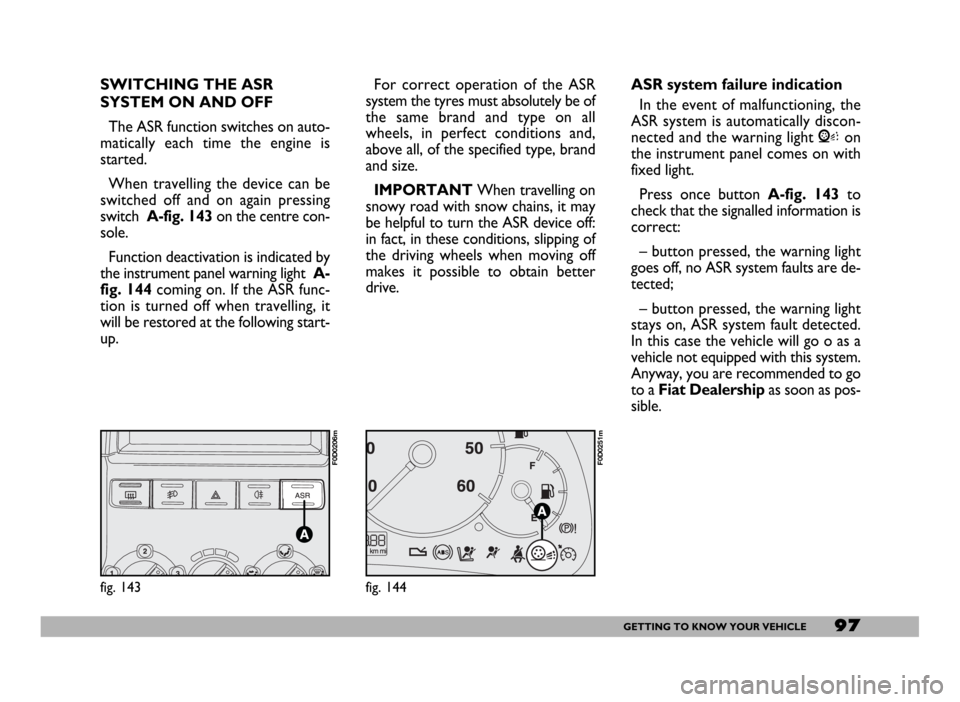
97GETTING TO KNOW YOUR VEHICLE
SWITCHING THE ASR
SYSTEM ON AND OFF
The ASR function switches on auto-
matically each time the engine is
started.
When travelling the device can be
switched off and on again pressing
switch A-fig. 143 on the centre con-
sole.
Function deactivation is indicated by
the instrument panel warning light A-
fig. 144coming on. If the ASR func-
tion is turned off when travelling, it
will be restored at the following start-
up.For correct operation of the ASR
system the tyres must absolutely be of
the same brand and type on all
wheels, in perfect conditions and,
above all, of the specified type, brand
and size.
IMPORTANTWhen travelling on
snowy road with snow chains, it may
be helpful to turn the ASR device off:
in fact, in these conditions, slipping of
the driving wheels when moving off
makes it possible to obtain better
drive.
fig. 143
F0D0206m
ASR system failure indication
In the event of malfunctioning, the
ASR system is automatically discon-
nected and the warning light Von
the instrument panel comes on with
fixed light.
Press once button A-fig. 143to
check that the signalled information is
correct:
– button pressed, the warning light
goes off, no ASR system faults are de-
tected;
– button pressed, the warning light
stays on, ASR system fault detected.
In this case the vehicle will go o as a
vehicle not equipped with this system.
Anyway, you are recommended to go
to a Fiat Dealershipas soon as pos-
sible.
fig. 144
F0D0251m
Page 122 of 258
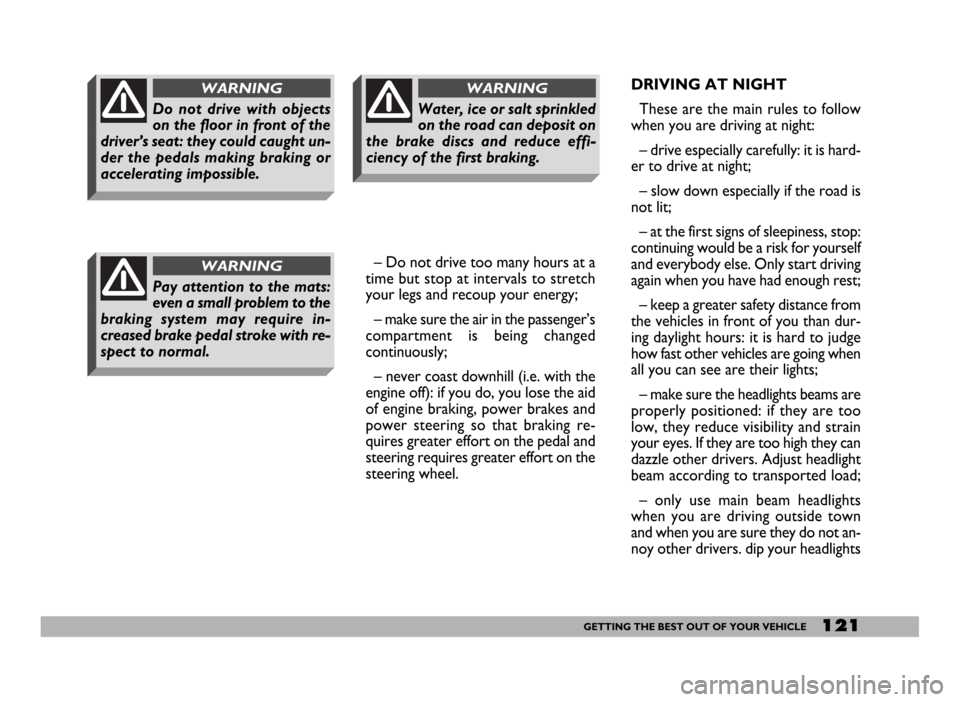
121GETTING THE BEST OUT OF YOUR VEHICLE
– Do not drive too many hours at a
time but stop at intervals to stretch
your legs and recoup your energy;
– make sure the air in the passenger’s
compartment is being changed
continuously;
– never coast downhill (i.e. with the
engine off): if you do, you lose the aid
of engine braking, power brakes and
power steering so that braking re-
quires greater effort on the pedal and
steering requires greater effort on the
steering wheel.DRIVING AT NIGHT
These are the main rules to follow
when you are driving at night:
– drive especially carefully: it is hard-
er to drive at night;
– slow down especially if the road is
not lit;
– at the first signs of sleepiness, stop:
continuing would be a risk for yourself
and everybody else. Only start driving
again when you have had enough rest;
– keep a greater safety distance from
the vehicles in front of you than dur-
ing daylight hours: it is hard to judge
how fast other vehicles are going when
all you can see are their lights;
– make sure the headlights beams are
properly positioned: if they are too
low, they reduce visibility and strain
your eyes. If they are too high they can
dazzle other drivers. Adjust headlight
beam according to transported load;
– only use main beam headlights
when you are driving outside town
and when you are sure they do not an-
noy other drivers. dip your headlights
Water, ice or salt sprinkled
on the road can deposit on
the brake discs and reduce effi-
ciency of the first braking.
WARNING
Do not drive with objects
on the floor in front of the
driver’s seat: they could caught un-
der the pedals making braking or
accelerating impossible.
WARNING
Pay attention to the mats:
even a small problem to the
braking system may require in-
creased brake pedal stroke with re-
spect to normal.
WARNING
Page 129 of 258
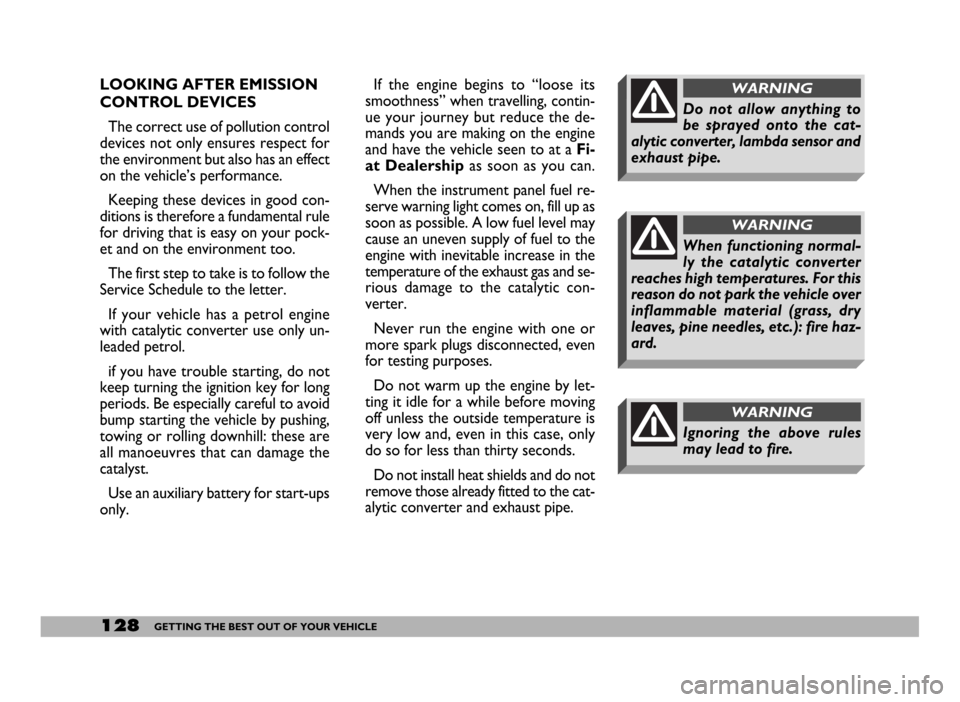
128GETTING THE BEST OUT OF YOUR VEHICLE
LOOKING AFTER EMISSION
CONTROL DEVICES
The correct use of pollution control
devices not only ensures respect for
the environment but also has an effect
on the vehicle’s performance.
Keeping these devices in good con-
ditions is therefore a fundamental rule
for driving that is easy on your pock-
et and on the environment too.
The first step to take is to follow the
Service Schedule to the letter.
If your vehicle has a petrol engine
with catalytic converter use only un-
leaded petrol.
if you have trouble starting, do not
keep turning the ignition key for long
periods. Be especially careful to avoid
bump starting the vehicle by pushing,
towing or rolling downhill: these are
all manoeuvres that can damage the
catalyst.
Use an auxiliary battery for start-ups
only.If the engine begins to “loose its
smoothness” when travelling, contin-
ue your journey but reduce the de-
mands you are making on the engine
and have the vehicle seen to at a Fi-
at Dealershipas soon as you can.
When the instrument panel fuel re-
serve warning light comes on, fill up as
soon as possible. A low fuel level may
cause an uneven supply of fuel to the
engine with inevitable increase in the
temperature of the exhaust gas and se-
rious damage to the catalytic con-
verter.
Never run the engine with one or
more spark plugs disconnected, even
for testing purposes.
Do not warm up the engine by let-
ting it idle for a while before moving
off unless the outside temperature is
very low and, even in this case, only
do so for less than thirty seconds.
Do not install heat shields and do not
remove those already fitted to the cat-
alytic converter and exhaust pipe.
Do not allow anything to
be sprayed onto the cat-
alytic converter, lambda sensor and
exhaust pipe.
WARNING
Ignoring the above rules
may lead to fire.
WARNING
When functioning normal-
ly the catalytic converter
reaches high temperatures. For this
reason do not park the vehicle over
inflammable material (grass, dry
leaves, pine needles, etc.): fire haz-
ard.
WARNING
Page 137 of 258
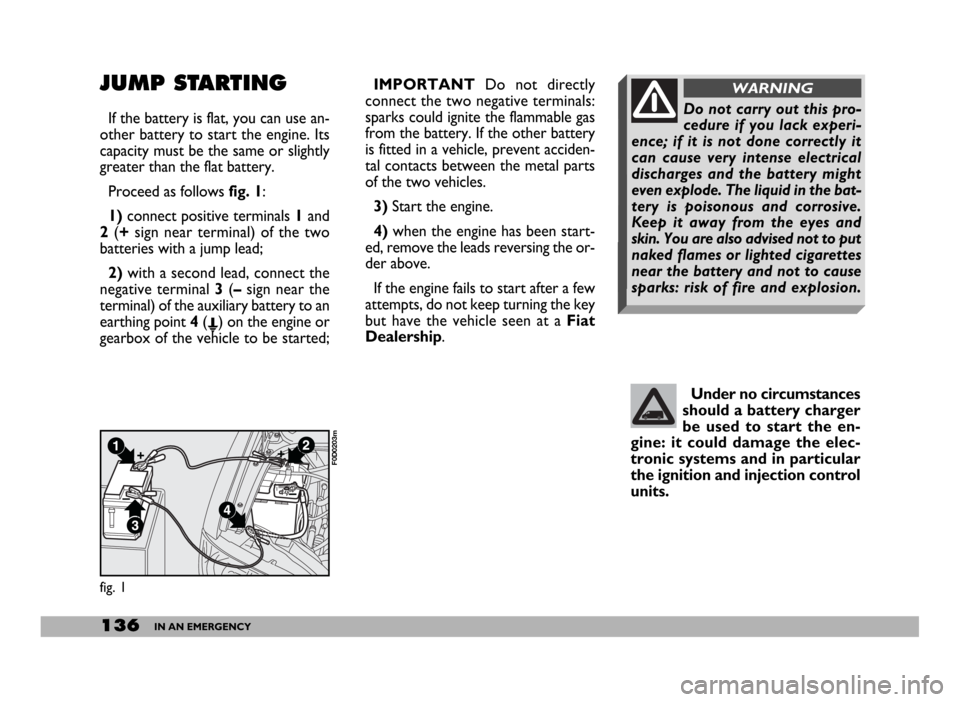
136IN AN EMERGENCY
JUMP STARTING
If the battery is flat, you can use an-
other battery to start the engine. Its
capacity must be the same or slightly
greater than the flat battery.
Proceed as follows fig. 1:
1) connect positive terminals1and
2 (+sign near terminal) of the two
batteries with a jump lead;
2) with a second lead, connect the
negative terminal 3(– sign near the
terminal) of the auxiliary battery to an
earthing point 4(E) on the engine or
gearbox of the vehicle to be started;IMPORTANTDo not directly
connect the two negative terminals:
sparks could ignite the flammable gas
from the battery. If the other battery
is fitted in a vehicle, prevent acciden-
tal contacts between the metal parts
of the two vehicles.
3) Start the engine.
4)when the engine has been start-
ed, remove the leads reversing the or-
der above.
If the engine fails to start after a few
attempts, do not keep turning the key
but have the vehicle seen at a Fiat
Dealership.
fig. 1
F0D0203m
Under no circumstances
should a battery charger
be used to start the en-
gine: it could damage the elec-
tronic systems and in particular
the ignition and injection control
units.
Do not carry out this pro-
cedure if you lack experi-
ence; if it is not done correctly it
can cause very intense electrical
discharges and the battery might
even explode. The liquid in the bat-
tery is poisonous and corrosive.
Keep it away from the eyes and
skin. You are also advised not to put
naked flames or lighted cigarettes
near the battery and not to cause
sparks: risk of fire and explosion.
WARNING
Page 144 of 258
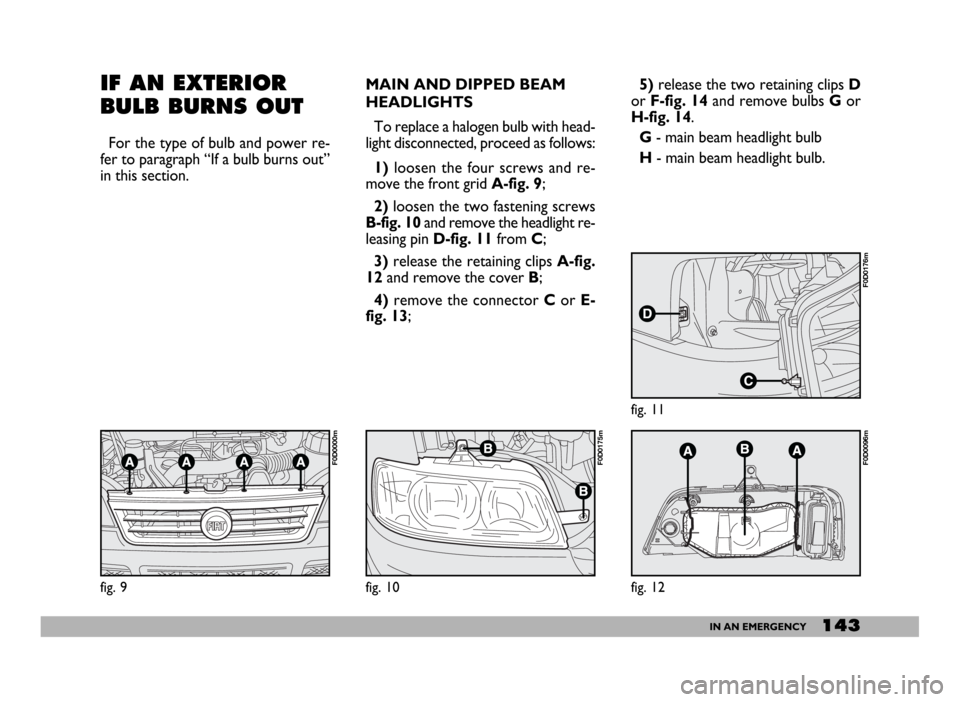
143IN AN EMERGENCY
MAIN AND DIPPED BEAM
HEADLIGHTS
To replace a halogen bulb with head-
light disconnected, proceed as follows:
1)loosen the four screws and re-
move the front grid A-fig. 9;
2)loosen the two fastening screws
B-fig. 10and remove the headlight re-
leasing pin D-fig. 11from C;
3)release the retaining clips A-fig.
12and remove the cover B;
4)remove the connector Cor E-
fig. 13;5)release the two retaining clips D
or F-fig. 14and remove bulbs Gor
H-fig. 14.
G- main beam headlight bulb
H- main beam headlight bulb.
fig. 12
F0D0096m
fig. 11
F0D0176m
fig. 10
F0D0175m
IF AN EXTERIOR
BULB BURNS OUT
For the type of bulb and power re-
fer to paragraph “If a bulb burns out”
in this section.
fig. 9
F0D0000m
Page 148 of 258
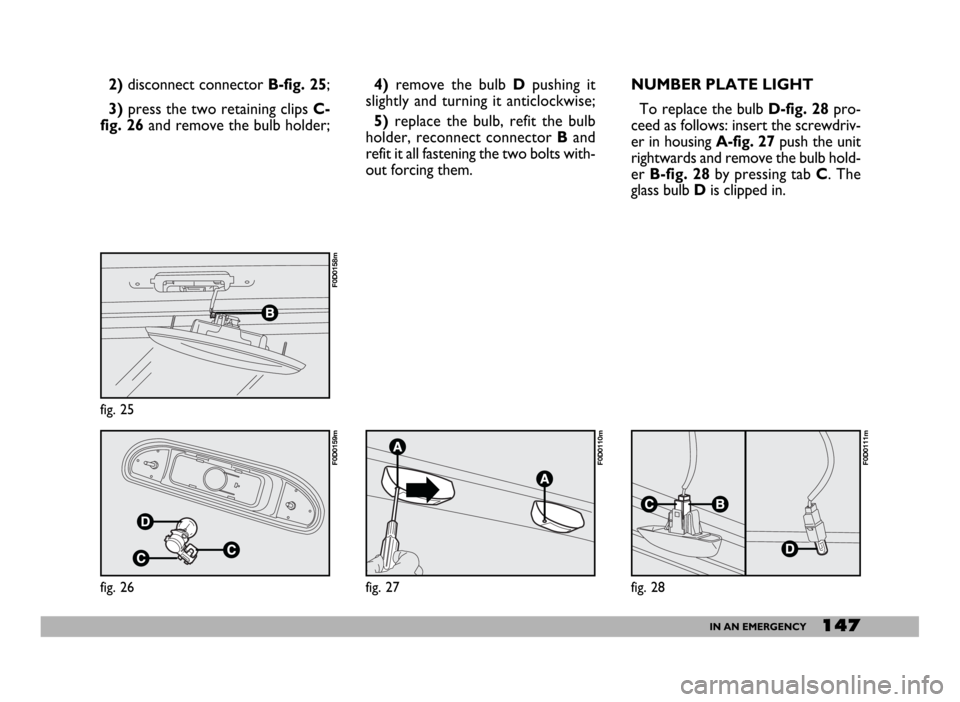
147IN AN EMERGENCY
NUMBER PLATE LIGHT
To replace the bulb D-fig. 28pro-
ceed as follows: insert the screwdriv-
er in housing A-fig. 27push the unit
rightwards and remove the bulb hold-
er B-fig. 28by pressing tab C. The
glass bulb Dis clipped in. 2)disconnect connector B-fig. 25;
3)press the two retaining clips C-
fig. 26and remove the bulb holder;4)remove the bulb Dpushing it
slightly and turning it anticlockwise;
5)replace the bulb, refit the bulb
holder, reconnect connector Band
refit it all fastening the two bolts with-
out forcing them.
fig. 25
F0D0158m
fig. 26
F0D0159m
fig. 27
F0D0110m
fig. 28
F0D0111m
Page 158 of 258
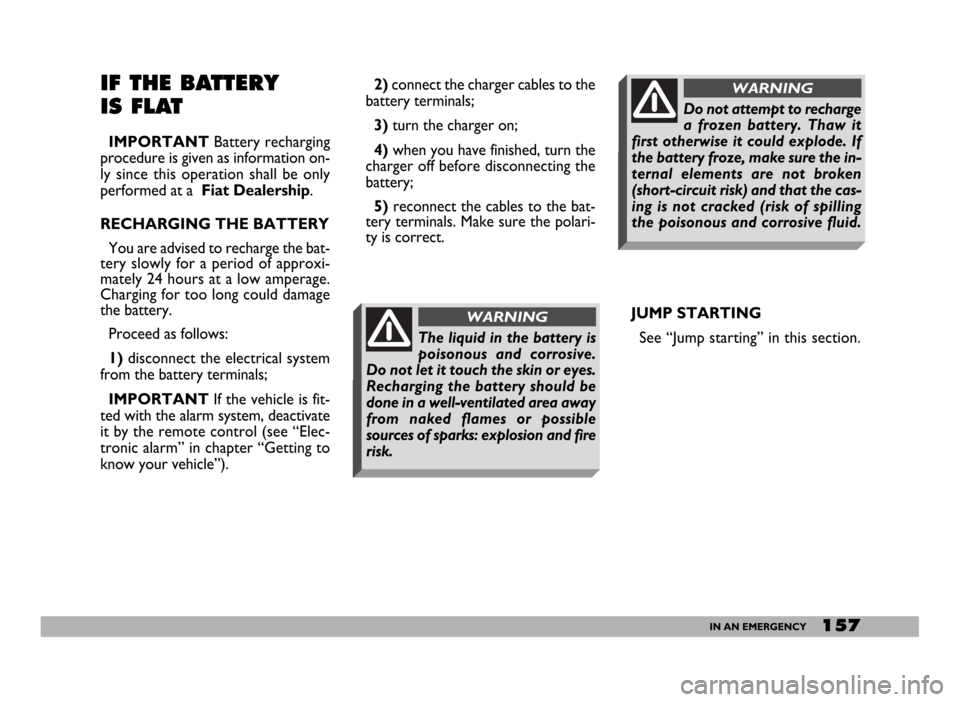
157IN AN EMERGENCY
IF THE BATTERY
IS FLAT
IMPORTANTBattery recharging
procedure is given as information on-
ly since this operation shall be only
performed at a Fiat Dealership.
RECHARGING THE BATTERY
You are advised to recharge the bat-
tery slowly for a period of approxi-
mately 24 hours at a low amperage.
Charging for too long could damage
the battery.
Proceed as follows:
1) disconnect the electrical system
from the battery terminals;
IMPORTANTIf the vehicle is fit-
ted with the alarm system, deactivate
it by the remote control (see “Elec-
tronic alarm” in chapter “Getting to
know your vehicle”).JUMP STARTING
See “Jump starting” in this section. 2)connect the charger cables to the
battery terminals;
3)turn the charger on;
4)when you have finished, turn the
charger off before disconnecting the
battery;
5) reconnect the cables to the bat-
tery terminals. Make sure the polari-
ty is correct.
The liquid in the battery is
poisonous and corrosive.
Do not let it touch the skin or eyes.
Recharging the battery should be
done in a well-ventilated area away
from naked flames or possible
sources of sparks: explosion and fire
risk.
WARNING
Do not attempt to recharge
a frozen battery. Thaw it
first otherwise it could explode. If
the battery froze, make sure the in-
ternal elements are not broken
(short-circuit risk) and that the cas-
ing is not cracked (risk of spilling
the poisonous and corrosive fluid.
WARNING